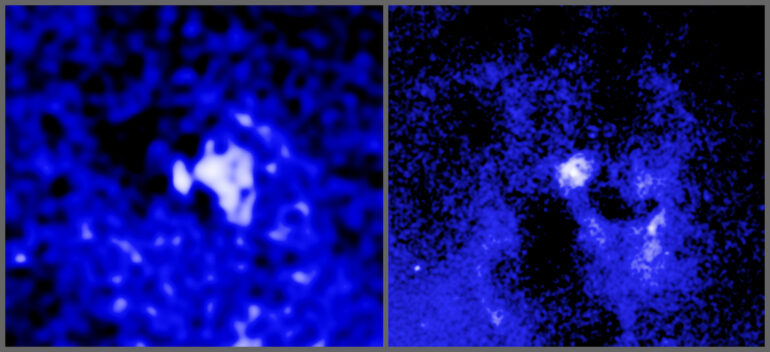Huge black holes are firing powerful beams of particles into space—and then changing their aim to fire at new targets. This discovery, made using NASA’s Chandra X-ray Observatory and the U.S. National Science Foundation (NSF) National Radio Astronomical Observatory’s (NRAO) Very Long Baseline Array (VLBA), shows what kind of widespread impact black holes can have on their surrounding galaxy and beyond.
A team of astronomers looked at 16 supermassive black holes in galaxies surrounded by hot gas detected in X-rays by Chandra. The paper is published in The Astrophysical Journal.
Using radio data from the VLBA, they studied the directions of beams—also known as jets—of particles fired a few light-years away from the black holes. This gives the scientists a picture of where each beam is currently pointed, as seen from Earth. Each black hole fires two beams in opposite directions.
The team then used Chandra data to study pairs of cavities, or bubbles, in the hot gas that were created in the past by the beams pushing gas outwards. The locations of large outer cavities indicate the direction those beams pointed millions of years earlier. The researchers then compared the directions of the radio beams with the directions of the pairs of cavities.
“We found that about a third of the beams are now pointing in completely different directions than before,” said Francesco Ubertosi of the University of Bologna in Italy, who led the study. “These Death Star black holes are swiveling around and pointing at new targets, like the fictional space station in Star Wars.”
The X-ray and radio data indicate that the beams can change directions over nearly 90 degrees in some cases, and over timescales between one million years and a few tens of millions of years.
“Considering that these black holes are likely more than 10 billion years old,” said co-author Gerrit Schellenberger of the Center for Astrophysics, Harvard & Smithsonian (CfA). “We consider a large change in direction over a few million years to be fast. Changing the direction of the giant black hole beams in about a million years is analogous to changing the direction of a new battleship in a few minutes.”
Scientists think that beams from black holes and the cavities they carve out play an important role in how many stars form in their galaxies. The beams pump energy into the hot gas in and around the galaxy, preventing it from cooling down enough to form huge numbers of new stars. If the beams change directions by large amounts, they can tamp down star formation across much larger areas of the galaxy.
“These galaxies are too distant to tell if the beams from the Death Star black holes are damaging stars and their planets, but we are confident they are preventing many stars and planets from forming in the first place,” said co-author Ewan O’Sullivan, also from CfA.
One of the biggest open questions is how these black hole beams turn like this. The direction of the beams from each of these giant black holes, which are likely spinning, is thought to align with the rotation axis of the black hole, meaning that the beams point along a line connecting the poles.
An important power source for these beams is likely matter in a disk spinning around the black hole and falling inwards. This process is thought to force the beams to be perpendicular to the disk. If material falls towards the black hole at a different angle that is not parallel to the disk, it could affect the direction of the black hole’s rotation axis.
“It’s possible that material rapidly falling towards the black holes at a different angle for long enough would drag their rotation axes in a different direction,” said co-author Jan Vrtilek, also from CfA, “causing the beams to point in a different direction.”
The team also considered alternative explanations for the mismatch between the directions of the radio beams and the cavities. One alternative is that gas is sloshing around in the cluster like wine in a glass being swirled in a circle. Sloshing like this might be caused by collisions between two clusters of galaxies that could move the cavities around.
However, the researchers found evidence of sloshing in both aligned and misaligned clusters, which argues against the possibility that sloshing is causing the cavities to move around large distances.
More information:
Francesco Ubertosi et al, Jet Reorientation in Central Galaxies of Clusters and Groups: Insights from VLBA and Chandra Data, The Astrophysical Journal (2024). DOI: 10.3847/1538-4357/ad11d8
Provided by
Chandra X-ray Center
Citation:
Astronomers observe jet reorientation in ‘Death Star’ black holes (2024, May 22)



